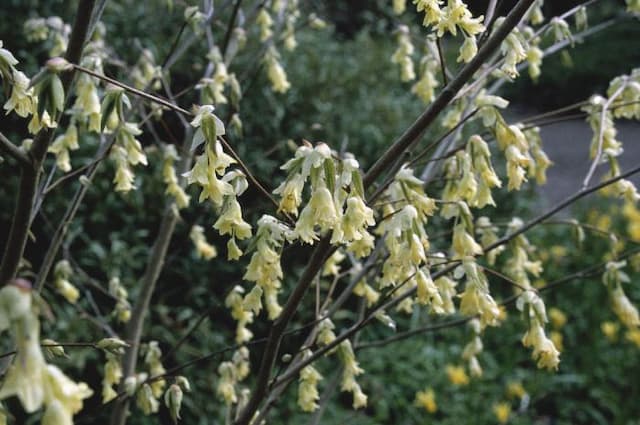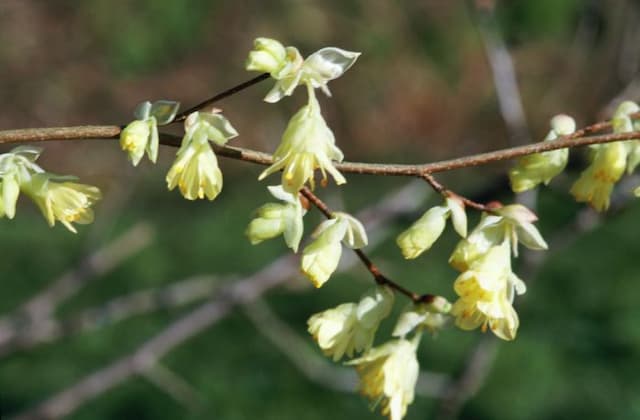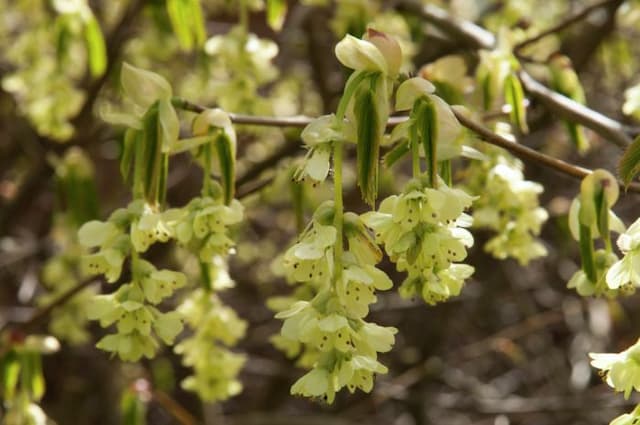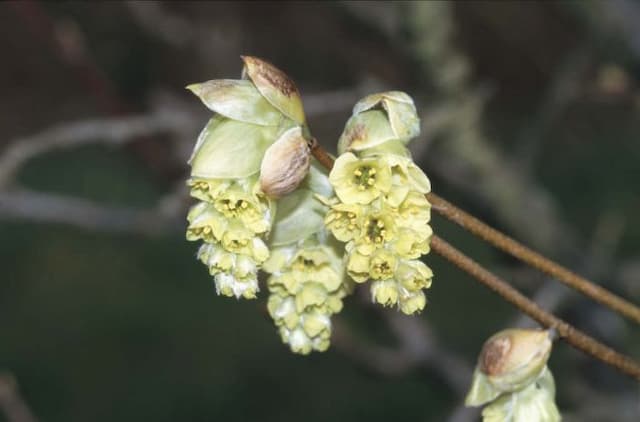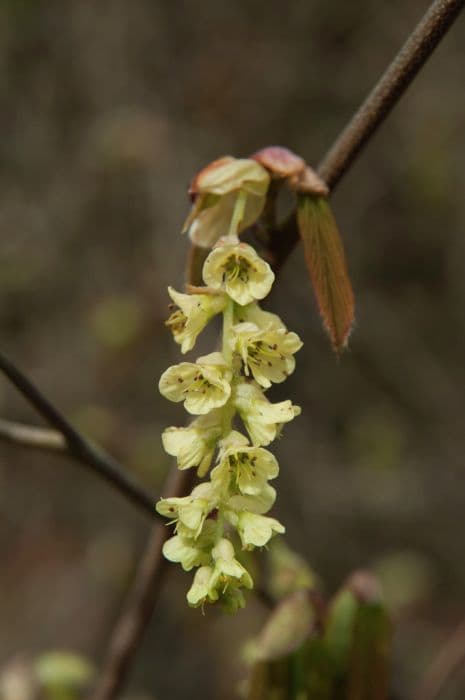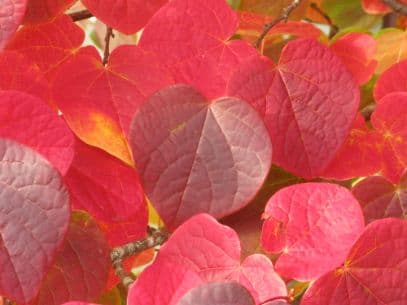Witch hazel Hamamelis × intermedia 'Orange Peel'

ABOUT
Witch Hazel 'Orange Peel' portrays a visually striking appearance with its vibrant, citrus-colored flowers that captivate onlookers. These distinctive blooms, which give the plant its nickname, bear a resemblance to the peel of an orange in both color and texture. The flowers appear ribbon-like, with slender, crinkled petals that dance on the bare branches of the shrub. These festive petals are typically arranged in clusters, adding to the plant's ornamental appeal. The overall effect of these blossoms against the stark branches is one of brilliant contrast, especially in a landscape that may be largely dormant. The foliage of Witch Hazel 'Orange Peel' is equally noteworthy, with leaves that display bold shapes and a rich green hue during the growing season. In autumn, these leaves undergo a transformation, turning into a palette of warm tones that can include yellows, oranges, and reds, mirroring the colors of its flowers and providing a prolonged display of color. Textured, grayish-brown bark covers the branches and stems, providing a rugged backdrop for both the dramatic flowers and the lush foliage. Witch Hazel 'Orange Peel' is certainly a plant that stands out in the garden with its picturesque blossoms and foliage, providing multi-season interest and a splash of vivid color.
About this plant
 Names
NamesSynonyms
Orange Peel Witch Hazel, Hybrid Witch Hazel
Common names
Hamamelis × intermedia 'Orange Peel'.
 Toxicity
ToxicityTo humans
Witch Hazel is generally considered non-toxic to humans. It does not commonly cause poisoning or toxic reactions when touched or ingested in small quantities. However, as with many plants, individual allergic reactions or sensitivity could occur, and it is always advisable to practice caution and avoid ingesting plant material that is not meant for consumption.
To pets
Witch Hazel is also considered to be non-toxic to pets. It is unlikely to cause poisoning if pets come into contact with it or ingest small amounts of the plant. Despite its relative safety, it is always best to prevent pets from eating plants to avoid any potential gastrointestinal upset or unexpected allergic reactions.
 Characteristics
CharacteristicsLife cycle
Perennials
Foliage type
Deciduous
Color of leaves
Green
Flower color
Orange
Height
10-15 feet (3-4.5 meters)
Spread
10-15 feet (3-4.5 meters)
Plant type
Shrub
Hardiness zones
5-8
Native area
Asia
Benefits
 General Benefits
General Benefits- Attractive Flowers: Witch Hazel 'Orange Peel' produces vibrant orange to yellow flowers that are especially striking in late winter or early spring when few other plants are in bloom.
- Winter Interest: It adds color and interest to the garden during the dreary winter months when most other plants are dormant.
- Wildlife Attraction: The flowers provide food for early-emerging pollinators such as bees when few other food sources are available.
- Low Maintenance: Once established, Witch Hazel requires minimal care, making it suitable for gardeners of all skill levels.
- Drought Tolerance: It is relatively drought-tolerant, which is useful in areas with water restrictions or for gardeners looking to conserve water.
- Landscape Versatility: Suitable for use in a variety of landscape situations, including as a specimen plant, in mixed borders, or woodland gardens.
- Fall Foliage: Offers attractive fall foliage, which adds another season of interest to the garden.
- Scented Flowers: The fragrant blooms can be a delightful aromatic addition to the garden.
- Deciduous Nature: As a deciduous shrub, it contributes to the ecosystem by providing organic matter to the soil as its leaves decompose.
- Pest Resistance: Generally resistant to many pests, reducing the need for chemical interventions in the garden.
 Medical Properties
Medical PropertiesThis plant is not used for medical purposes.
 Air-purifying Qualities
Air-purifying QualitiesThis plant is not specifically known for air purifying qualities.
 Other Uses
Other Uses- Witch hazel 'Orange Peel' branches can be used in floral arrangements, particularly during the winter months when the vibrant blooms and unique fragrance add an unexpected touch of color and scent.
- This plant's extract can be utilized in natural insect repellents due to its astringent properties, which can be unpleasant for insects.
- As a natural dye, witch hazel 'Orange Peel' can be used to obtain warm, yellow tones for fabrics and yarns when boiled and strained.
- The twigs and bark of witch hazel 'Orange Peel' are sometimes employed in divining or water dowsing practices as flexible divining rods.
- Used in photography, witch hazel 'Orange Peel' tannins can be extracted to create a natural alternative to chemical fixatives for certain types of photographic prints.
- Its fragrant petals can be dried and incorporated into potpourri blends to add a gentle fragrance to rooms.
- Gardeners might use witch hazel 'Orange Peel' as a companion plant to discourage deer and other herbivores, who are generally deterred by the astringent taste of the leaves.
- Its dense branching pattern creates protective habitat and foraging space for birds and other wildlife during the winter months.
- Sustainable woodcrafters may use witch hazel 'Orange Peel' wood to craft small objects such as tool handles, spindles, or intricate carvings.
- The plant’s seed capsules can be used in a decorative fashion; when they mature and dry, they burst open with a distinctive snapping sound, adding auditory interest to a garden space.
Interesting Facts
 Feng Shui
Feng ShuiThe Witch Hazel is not used in Feng Shui practice.
 Zodiac Sign Compitability
Zodiac Sign CompitabilityThe Witch Hazel is not used in astrology practice.
 Plant Symbolism
Plant Symbolism- Rare Beauty: Hamamelis, also known as Witch Hazel, blooms in the middle of winter, showcasing its rare beauty when most other plants are dormant. 'Orange Peel', with its bright orange flowers, exemplifies this unique charm.
- Healing and Protection: Witch Hazel has been commonly associated with its medicinal properties, used traditionally to heal skin irritations and inflammation. This symbolism carries the idea of healing and protection.
- Resilience and Endurance: Witch Hazel's ability to bloom in adverse conditions symbolizes resilience and the capacity to endure challenges.
- Nature's Timing: The plant flowers in late winter, just before spring, symbolizing nature's timing and the concept that everything has its season.
 Water
WaterWitch Hazel 'Orange Peel' prefers consistently moist soil, but it's important not to overwater. During the growing season, water the plant deeply once a week, providing about 1 to 2 gallons depending on the size of the plant and the weather conditions. In hot, dry periods, you may need to water twice a week. During winter, reduce watering to every two to three weeks as the plant's water requirements decrease. Always check the soil moisture level before watering to ensure the soil is not already saturated.
 Light
LightWitch Hazel 'Orange Peel' thrives in full sun to partial shade. The ideal spot for this plant is one where it gets at least 4 to 6 hours of direct sunlight but is also protected from the harsh afternoon sun during the hottest part of the day. A location with morning sunlight and afternoon shade is often ideal.
 Temperature
TemperatureWitch Hazel 'Orange Peel' is a hardy plant that can tolerate a wide range of temperatures. It can withstand winter temperatures down to 0 degrees Fahrenheit and will thrive in areas where summer temperatures do not often exceed 90 degrees Fahrenheit. The ideal temperature range for this plant is between 30 and 70 degrees Fahrenheit, where it can grow and flower most efficiently.
 Pruning
PruningPruning Witch Hazel 'Orange Peel' helps to maintain its shape and encourages healthy growth. Prune in early spring, before the new growth starts, or right after the flowering period has ended. Remove any dead or crossing branches and thin out overcrowded areas to allow light and air to penetrate the plant. Typically, pruning Witch Hazel once a year is sufficient.
 Cleaning
CleaningAs needed
 Soil
SoilThe Witch Hazel 'Orange Peel' prefers well-drained, loamy soil enriched with organic matter. A slightly acidic to neutral pH of 5.5 to 7 will support its growth. For ideal soil mix, combine garden soil, compost, and perlite or coarse sand to ensure good drainage.
 Repotting
RepottingWitch Hazel 'Orange Peel' is typically grown in the ground and does not require repotting. However, if grown in a container, it should be repotted every 3-5 years, or when it becomes root-bound.
 Humidity & Misting
Humidity & MistingWitch Hazel 'Orange Peel' can tolerate a range of humidity levels but prefers average to high humidity in its environment, especially when grown indoors. Aim for relative humidity around 40-60% for optimal growth.
 Suitable locations
Suitable locationsIndoor
Keep Witch Hazel 'Orange Peel' near a sunny window and mist regularly.
Outdoor
Plant Witch Hazel 'Orange Peel' in partial sun and well-drained soil.
Hardiness zone
5-8 USDA
 Life cycle
Life cycleThe Witch Hazel 'Orange Peel' starts its life as a seed, which after experiencing a period of cold dormancy, germinates in spring to produce a small seedling. As it grows, the seedling develops into a young shrub with characteristic broad green leaves. In mature plants, flowering typically occurs in late winter to early spring before the new leaves emerge, showcasing its fragrant orange flowers. After pollination, usually by wind or insects, the shrub produces seed capsules that mature in autumn and can explosively eject seeds several meters away. The plant continues to grow and increase in size each year, building a woody structure that can last for decades. Witch Hazel 'Orange Peel' eventually reaches a natural end to its lifecycle when old age, environmental stresses, or disease lead to its decline and death.
 Propogation
PropogationPropogation time
Late winter-early spring
Propogation: The Witch Hazel 'Orange Peel' can be propagated through the most popular method of softwood cuttings. This is typically done during late spring or early summer when new growth is still flexible but has begun to mature. To propagate, take a cutting of about 4 to 6 inches (10 to 15 centimeters) from a healthy branch, making sure there are several sets of leaves. Strip the leaves from the lower half of the cutting and dip the cut end into a rooting hormone powder to encourage root development. Then, insert the cutting into a well-draining potting mix and cover with a plastic bag to maintain high humidity. Place the cutting in indirect light and keep the soil moist but not waterlogged. Roots usually form within 4 to 8 weeks, depending on the environmental conditions.
